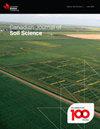保护性耕作实践的经济回顾:加拿大东部大草原的案例研究 & # x0D;
IF 1.5
4区 农林科学
Q4 SOIL SCIENCE
引用次数: 0
摘要
本研究回顾了有关土壤保持措施的文献,并分析了加拿大西部马尼托巴省(MB)不同土壤带和不同耕作制度的4个案例,以揭示免耕/少耕措施对大田作物经济效益的潜在影响。利用主要和次要数据,如耕作方式、投入成本、作物价格、作物产量和净收入(NR)来评估每个案例研究中的耕作方式。根据马尼托巴省南部9年(1998-2006年)的作物经济分析,在保护性耕作下,以谷物为基础的春小麦(Triticum aestivum L.)、大麦(Hordeum vulgare L.)种植系统比传统耕作方式更有利可图,而油籽作物(如油菜、甘油瓜)则相反。在Portage, MB的小区尺度研究中,与高强度耕作相比,低强度耕作在3年中有1年增加了大豆(Glycine max L.)的NR,并且随着耕作强度的增加,油菜的NR似乎降低了。然而,在布兰顿附近的研究中,4年小麦-豌豆轮作(Pisum sativum L.)在低干扰播种系统中比在高干扰播种系统中低,但在壤土中相似。虽然根据这些案例研究,没有发现单一的耕作系统能够始终提供最高的NR,但这些发现为围绕耕作管理决策背后的一些因素提供了见解,并为加拿大东部草原继续使用传统,减少和零耕作系统的组合提供了理由。本文章由计算机程序翻译,如有差异,请以英文原文为准。
An economic review of conservation tillage practices: select case studies from the eastern Prairies of Canada
This study reviewed the literature on soil conservation practices and analyzed four case studies in different soil zones and diverse cropping systems of Manitoba (MB), western Canada to show the potential impacts of no-till/reduced tillage practices on field crop economic performance. Primary and secondary data, such as tillage type, input cost, crop price, crop yield, and net revenue (NR) were used to assess the tillage practices in each of the case studies. Based on crop economic analysis over nine years (1998-2006) in Southern Manitoba, cereal-based (spring wheat (Triticum aestivum L.), barley (Hordeum vulgare L.) cropping systems were more profitable under conservation tillage than conventional tillage practices, whereas the opposite was true for oilseed crops (e.g., canola, Brassica napus L.). In plot-scale studies at Portage, MB, low intensity tillage increased NR for soybean (Glycine max L.) in 1 of 3 years when compared to high intensity tillage and there appeared to be lower NRs for canola as tillage intensity increased. However, in studies near Brandon, MB, NRs for a 4-year wheat-pea (Pisum sativum L.) rotation were lower in low disturbance seeding than high disturbance seeding systems for a clay loam soil but similar for a loam soil. While no single tillage system was found to consistently provide the highest NR based on these case studies, these findings provide insights into some of the factors behind decisions surrounding tillage management and the rationale for the continued use of a combination of conventional, reduced and zero-till systems in the eastern Prairies of Canada.
求助全文
通过发布文献求助,成功后即可免费获取论文全文。
去求助
来源期刊

Canadian Journal of Soil Science
农林科学-土壤科学
CiteScore
2.90
自引率
11.80%
发文量
73
审稿时长
6.0 months
期刊介绍:
The Canadian Journal of Soil Science is an international peer-reviewed journal published in cooperation with the Canadian Society of Soil Science. The journal publishes original research on the use, management, structure and development of soils and draws from the disciplines of soil science, agrometeorology, ecology, agricultural engineering, environmental science, hydrology, forestry, geology, geography and climatology. Research is published in a number of topic sections including: agrometeorology; ecology, biological processes and plant interactions; composition and chemical processes; physical processes and interfaces; genesis, landscape processes and relationships; contamination and environmental stewardship; and management for agricultural, forestry and urban uses.
 求助内容:
求助内容: 应助结果提醒方式:
应助结果提醒方式:


